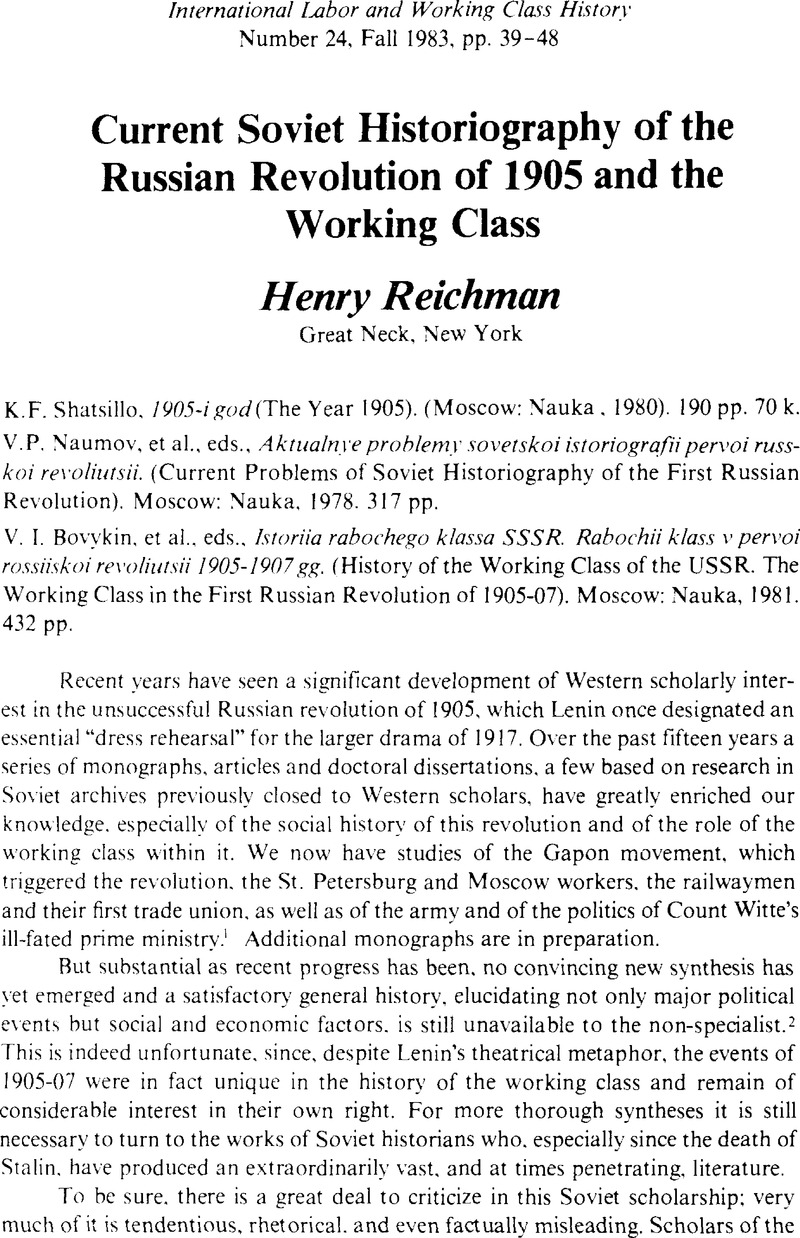No CrossRef data available.
Published online by Cambridge University Press: 16 December 2008

1. On the Gaponovshchina see Sablinsky, Walter, The Road to Bloody Sunday: Father Gapon and the St. Petersburg Massacre of 1905 (Princeton, 1976)Google Scholar and the fine article by Surh, Gerald in Russian Review, 40 (1981).Google ScholarThe Petersburg and Moscow workers are examined in Surh. “Petersburg Workers in 1905: Strikes. Workplace Democracy and the Revolution” (Ph.D dissertation. University of California. Berkeley. 1979) andGoogle ScholarEngelstein, Laura, Moscow, 1905: Working Class Organization and Political Conflict (Stanford, 1982)Google Scholar. On the railwaymen see my own “Russian Railwaymen and the Revolution of 1905” (Ph.D dissertation, U. C., Berkeley, 1977)Google Scholar and Sablinsky, , “The All-Russia Railroad Union and the Beginning of the General Strike in October, 1905” in Rabinowitch, Alexander et al. , eds., Revolution and Politics in Russia (Bloomington 1972)Google Scholar. The army has been ably discussed in Rushnell, John “Mutineers and Revolutionaries: Military Revolution in Russia, 1905–1907” (Ph.D dissertation, Indiana University, 1977)Google Scholar and the politics of the Witte ministry in Mehlinger, Howard and Thompson, John M., Count Witte and the Tsarist Government in the 1905 Revolution (Bloomington, 1972)Google Scholar.
2. The sole general account of the events of 1905 in English is Harcave, Sidney. First Blood: The Russian Revolution of 1905 (London. 1964)Google Scholar. but it is very weak on the mass movement and the social aspects of the revolution and has been otherwise dated by subsequent research. Schwarz's, Solomon provocative The Russian Revolution of 1905 (Chicago. 1967)Google Scholar is more in the nature of a polemical memoir than the general history suggested by its title.
3. Several other Soviet narratives of the events of 1905–07 appeared in the mid-1960s including works by N. N. Demochkin. L. K. Erman. and E. D. Chermenskii; V. I. Bovykin; and A. V. Piaskovskii. Until the appearance of the works under review here, the “standard” account was the collective volume produced by an editorial group headed by Korablev, Iu. O. (and including Shat-sillo). 1905–1907 godov v Rossii (Moscow. 1975)Google Scholar.
4. Examples include Pokrovsky, M. N.. Rol' rabochego klassa v revoliutsii 1905 goda (Moscow. 1930)Google Scholar and 1905 god (Moscow. 1930); Nevskii, V. I., Sovety i vooruzhennoe vosstanie v 1905 godu (Moscow. 1932)Google Scholar; and the three-volume collection. 1905, Istoriia revoliutsionnogo dvizheniia v otdelnykh ocherkakh (Moscow-Leningrad. 1925–1927) edited by Pokrovsky, Google Scholar.
5. Iakovlev, N. N.. Vooruzhennye vosstaniia v dekahre 1905g. (Moscow. 1957)Google Scholar; Demochkin, N. N.. Sovety 1905 goda — organy revoliutsionnoi vlasti (Moscow. 1963)Google Scholar; Erman, L. K.. Intelligentsiia v pervoi russkoi revoliutsii (Moscow. 1966)Google Scholar.
6. “O 70-letii revoliutsii 1905–1907 godov v Rossii,” Kommunist. 2. 1975. pp. 3–6Google Scholar. The two controversial 1970 titles were: Rossiiskii proletariat: oblik, bor'ba, gegemoniia (Moscow, 1970)Google Scholar and Sverzhenie samoderzhaviia. sbornik statei (Moscow, 1970)Google Scholar. Several of their key theses came under sharp criticism in Volin, M. S.. Derenkovskii, G. M.. and Kolecnichenko, D. A.. “O gegemonii proletariata v pervoi russkoi revoliutsii.” Istoriia SSSR, 4. 1973. pp. 46–47Google Scholar.